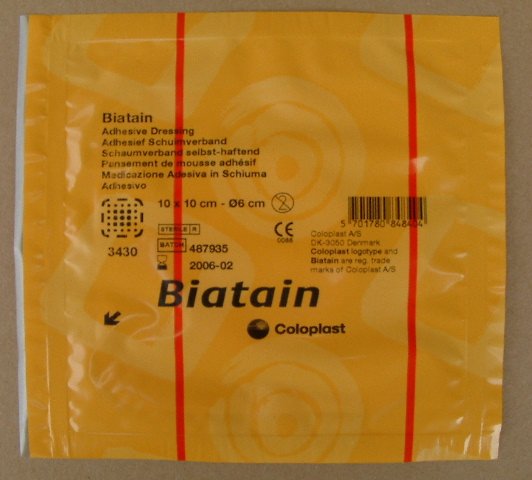
| Product Name: | Biatain Adhesive |
| Classification Name: | Dressing polyurethane foam/film adhesive |
| Manufacturer: | Coloplast |

Biatain Adhesive dressing consists of an absorbent soft polyurethane foam pad located centrally upon a larger polyurethane membrane coated with a hydrocolloid adhesive forming an island dressing. backing film is permeable to water vapour, but impermeable to microorganisms thus forming an effective bacterial barrier. When applied to an exuding wound, the polyurethane foam pad absorbs and retains excess exudate, whilst the film backing permits controls evaporative loss of moisture, which stops the dressing and wound from drying out thus maintaining a warm moist healing environment within the wound. Provided the adhesive border forms an effective seal with the peri-wound skin, the dressing is waterproof, and the patient may bathe or shower with it in place.
Biatain Adhesive is indicated for the treatment of moderate to heavily exuding wounds such as leg ulcers, pressure ulcers, superficial and partial thickness burns, donor sites, postoperative wounds and skin abrasions. The dressing may be used throughout the healing process, and may be applied under compression bandages.
Biatain Adhesive dressings are not recommended for use with oxidizing solutions e.g. hypochlorite solutions or hydrogen peroxide and should not be applied to patients who are known to be sensitive to one of the components.
If clinically indicated, the wound should be cleansed in accordance with normal practice and the surrounding skin thoroughly dried before application of the adhesive sheet. A dressing should be selected that provides 1-2 cm overlap around the wound margin to ensure good adhesion. Using the 'non-touch' applicators to ensure sterile application, locate the foam pad over the wound and remove the backing films one at a time whilst smoothing the dressing onto the skin.
The frequency of dressing changes will be governed by the state of the wound. On clean epithelialising wounds the dressing may be left in place for up to seven days, but on more heavily exuding wounds more frequent changes may be required. It is recommended that the dressing be changed when the exudate approaches 2 cm from the margin.
Wounds on patients dressed with Biatain Adhesive with local and systemic infections and/or wounds caused by arterial insufficiency or diabetes, primarily on the lower leg or foot, should be inspected by a healthcare professional on a daily basis. In the event of an allergic reaction, the manufacturer should be contacted for information on dressing components.
Biatain Adhesive is presented individually wrapped in a peel pouch, sterilized by beta irradiation. The dressings are available in the form of squares for routine use, with specially designed shaped versions available for dressing sacral, heel and difficult to dress areas.
10cm x 10cm
12cm x 12cm
18cm x 18cm
Contour 17cm round
23cm x 23cm Sacral dressings
19cm x 20cm Heel dressings
1.Pritchard V. Treatment of a patient with a deep leg ulcer using Biatain Adhesive. Br J Nurs 1999;8(17):1164-7.
2.Andersen KE, Franken CPM, Gad P, Larsen AM, Larsen JR, van N, A., et al. A randomized, controlled study to compare the effectiveness of two foam dressings in the management of lower leg ulcers. Ostomy Wound Management 2002;48(8):34-41.
3.Lohmann, M. et al., Safety and performance of a new non-adhesive foam dressing for the treatment of diabetic foot ulcers. Journal of Wound Care 2004;13(3):118-120.
4.Thomas, S. et al, "An in-vitro comparison of the physical characteristics of hydrocolloids, hydrogels, foams and alginate/CMC fibrous dressings.", 2005, www.dressings.org
Available on Drug Tariff - Further information on obtaining Coloplast products is available on the
Coloplast web site.
| Revision Author | Dr S. Thomas |
| Revision No | 1.1 |
| Revision date | 2005/07/12 |
This datacard has been prepared from data provided by the manufacturer and/or from published literature.